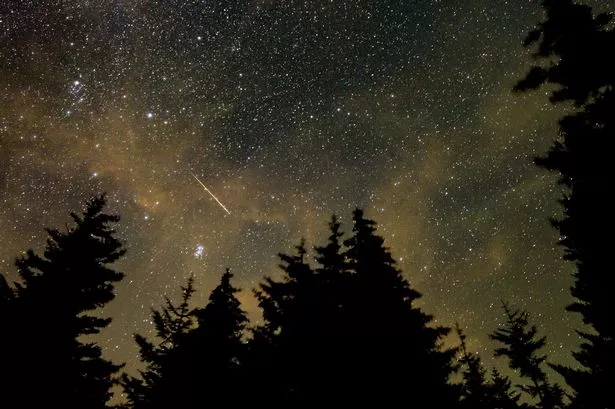Meteors burn up as they enter Earth’s atmosphere at a rapid speed A meteor streaks across the sky during the annual Perseid meteor shower, (Image: 2021 NASA/Bill Ingalls/Getty Images)
A meteor streaks across the sky during the annual Perseid meteor shower, (Image: 2021 NASA/Bill Ingalls/Getty Images)
This month stargazers can look forward to a spectacular meteor shower. Throughout the year meteors can often be spotted burning across the sky at incredible speeds. The space rocks are often called “shooting stars”.
Meteors burn up as they enter Earth’s atmosphere at a rapid speed. Scientists estimate that about 48.5 tons (44 tonnes or 44,000 kilograms) of meteoritic material falls on Earth each day. Almost all the material is vaporised in Earth’s atmosphere, leaving a bright trail.
There are plenty of meteor showers that can be enjoyed from Earth every year, perhaps the most spectacular of all is the Perseids. The Perseids are a prolific meteor shower associated with the comet Swift–Tuttle that are usually visible from mid-July to late-August. it is considered the best meteor shower of the year.
In 2025 the Perseid meteor shower is active between July 17 and August 24. The shower will peak August 12. It is famous for its swift and bright meteors, Perseids frequently leave long “wakes” of light and colour behind them as they streak through Earth’s atmosphere. The Perseids are one of the most plentiful showers with about 50 to 100 meteors seen per hour.
According to NASA: “Meteors come from leftover comet particles and bits from broken asteroids. When comets come around the Sun, they leave a dusty trail behind them.
“Every year Earth passes through these debris trails, which allows the bits to collide with our atmosphere and disintegrate to create fiery and colourful streaks in the sky.”
The Perseids are best viewed in the Northern Hemisphere during the pre-dawn hours, though at times it is possible to view meteors from this shower as early as 10pm. The Perseids are caused by the Earth slamming into the debris left behind by comet 109P/Swift-Tuttle.
The long duration of the meteor shower means there are plenty of opportunities to catch a glimpse of a meteor or two making its way across the sky.
The shower will appear to radiate from the constellation of Perseus, so it is recommended that you find a dark spot and look there for the best chance of seeing some shooting stars.
Royal Museums Greenwich (RMG) has explained the best time to see the meteor shower: “The radiant of the Perseids is actually always above the horizon as seen from the UK, which means that observers in the UK should be able to see some meteors as soon as the Sun sets. Therefore, it is worth looking up in the early evening.
“The best time to see the Perseids is between 12:00 midnight and 5:30am. It is always ideal to try to spot meteors when the Moon is below the horizon or when it is in its crescent phase, otherwise it acts as natural light pollution and prevents the fainter meteors from being visible.
RMG adds: “The Perseid meteor shower is one of the best meteor showers of the year because it produces bright meteors and is one of the most active.
“There’s also a high chance of seeing fireballs, which are very bright meteors, as well as meteors with long trains during the Perseid meteor shower.”
Perseids Meteor Shower
Comet of origin: 109P/Swift-Tuttle
Radiant: Constellation Perseus
Active: July 17 to August 23, 2025
Observed under dark skies: About 25 meteors per hour
Meteor Velocity: 37 miles per second, according to American Meteor Society
